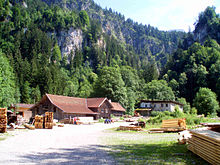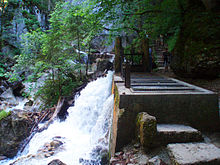Gypsum mill Schwangau
The gypsum mill was a mill system driven by the water of the Pöllat below Neuschwanstein Castle near Schwangau in the Ostallgäu .
history
In the gypsum mill, the burnt gypsum or anhydride portion of the Raibler layers was crushed, which lay as a narrow band in front of the rocks of Wetterstein lime; they were mined here above ground. [Marble - metamorphic carbonate rock - does not exist in the northern Limestone Alps; nor would it be ground in a plaster of paris mill - and if it were ground it would no longer be weatherproof.] The plaster of paris was transported cheaply down the Lech in sacks on rafts and sold. It was used partly as fertilizer, but mainly as plaster of paris - very popular in the baroque and rococo periods. It was used to decorate the many castles, churches and monasteries that were built in Swabia and Upper Bavaria in the 17th and 18th centuries. A sawmill was built next to the gypsum mill in the middle of the 19th century, which was partially renovated in 1889 and expanded in 1901/02 and is now also a listed building.
Current condition
In 1988, the listed building, which had a steep pitched roof from the mid-19th century, was partially destroyed by a fire. Since the building is on hiking trails that are heavily frequented by tourists, there were plans to rebuild the ruins. In 2011 a new building was announced. The water supply from the Pöllat Gorge is still well preserved.
literature
- Schwangau. Village of the royal castles . 1996, p. 20.
Individual evidence
- ^ Herbert Scholz, Building and Becoming the Allgäu Landscape , Stuttgart 1995
- ↑ http://www.gipsmuehle.de/ Retrieved on July 25, 2012.
Coordinates: 47 ° 33 '38.1 " N , 10 ° 45' 5.7" E


